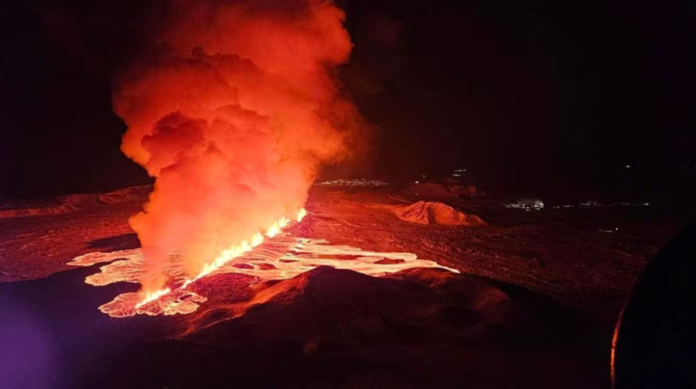A volcano in Iceland erupted on Thursday for the second time this year, spewing lava up to 80 metres into the air in what is the sixth outbreak on the southwestern Reykjanes peninsula since 2021, according to Reuters.
Live video from the area showed fountains of bright-orange molten rock spewing from fissures in the ground, in sharp contrast to the still-dark night sky.
“Warning: A volcanic eruption started north of Sylingarfell,” the country’s meteorological office said on its website.
Intense earthquake activity began around 5:30 a.m. and the outbreak itself started some 30 minutes later, it added.
The eruptive fissure was roughly 3 km long, the Met Office said, adding that the outbreak was believed to be in the same location as a December 18 eruption.
The nearby geothermal spa Blue Lagoon had closed on Thursday, it said.
The Reykjanes outbreaks are so-called fissure eruptions which are often referred to as Icelandic-type. They do not usually result in large explosions or significant production of ash dispersed into the stratosphere.
Reykjavik’s international Keflavik airport was open and operating “in the usual way,” airport operator Isavia said on its website.
The previous eruption in the area started on January 14 and lasted roughly two days, with lava flows reaching the outskirts of the Grindavik fishing town, whose nearly 4,000 inhabitants had been evacuated, setting some houses alight.
The Sylingarfell mountain is located north of Grindavik, but it was not immediately clear if Thursday’s outbreak would affect the village or a nearby power station.
Icelandic authorities in November started building dykes that can help divert burning lava flows away from homes and critical infrastructure.
Despite downgrading the volcanic system’s threat level, the local authorities have warned of further eruptions as land continued to rise in the area due to magma accumulating underground.
Iceland, which is roughly the size of the U.S. state of Kentucky, boasts more than 30 active volcanoes, making the north European island a prime destination for volcano tourism – a niche segment that attracts thousands of thrill seekers.


